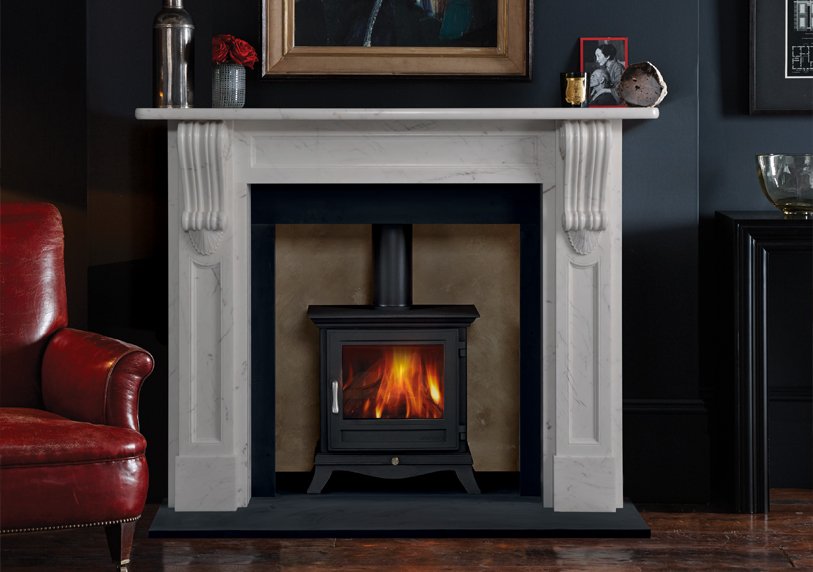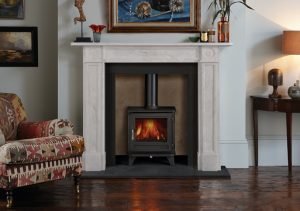

While you might primarily choose a wood burning stove for its luxury and elegance rather than its practicality, these modern appliances are more versatile than many realise. With the right information and approach, a log burner can be used to heat not just the room it sits within, but an entire home. Each fine detail, from the way you stack the logs to the placement of your stove, can change the efficiency with which your fire burns. In this article, we’ll share some tips to help you to get the most from your wood burning stove, maximising your energy efficiency and saving you money on heating bills.
BUILD A FIRE WITH LONG-LASTING WARMTH
If you want to heat your whole house with a wood burning stove, it’s essential that you learn how to fill it with a fire that creates consistent heat without rapidly burning through fuel. It’s easy enough to throw a random assortment of logs into the stove, but doing so is a recipe for fires that fizzle out quickly and fail to reach temperatures sufficient for a cosy home.

Wood burns best on a bed of ash, so refrain from clearing it out of your stove every time you use it. While excessive ash can cause problems, a moderate amount is preferable. Create a hash shape using small split logs with a firelighter or two in the middle, and top this structure with a bundle of kindling. Light the firelighters directly – once they’ve caught, the fire will spread to your kindling and eventually cause the logs to ignite, providing the foundation for the perfect fire. When it’s burning nicely, add a larger log on top of the pile to serve as the main source of fuel. Close the air vents on your stove to halfway to prevent your fire from burning out too quickly. You can use the primary vent to moderate the size of the fire, opening it up to add more oxygen and increase the size of the fire. This is particularly useful when you need to add a new log and want it to catch quickly. When you want the fire to die down, close the air vents – the flames will soon burn out once their oxygen supply has diminished. By practising and perfecting this method in a quality stove, anyone can benefit from the comfortable heat a wood burner brings.
One important thing to note is that the quality of your fire will also depend on the type of wood you’re burning. For the optimum burn rate, use logs that have been seasoned for at least a year, with a moisture content of 20% or below, which can be measured using a wood moisture meter. The best woods to burn include oak, birch, ash and hazel. Logs from these trees burn slowly, split easily and produce fewer sparks than other types of wood, creating fires that generate long-lasting, consistent heat.
Read stove expert, Huw Williams’ guide to wood-burning and safe use of stoves.

PLACE YOUR STOVE IN THE OPTIMAL POSITION
You may have mastered the art of perfect fire building, but if your stove is in the wrong place, it’s unlikely to spread heat effectively throughout your house. If you want your wood burning stove to distribute its warmth consistently around your home, the most important thing is to have it installed downstairs. Since heat rises, ground floor stoves can easily spread their heat into upstairs rooms.
You can further encourage the spread of heat from your wood burning stove by installing vents in the ceiling of the room where the stove is located, as well as vents in any upstairs rooms you want to benefit from the stove’s heat. Convection heat generated from your stove will rise through your ceiling and spread into rooms where other vents are installed, allowing for greater energy efficiency throughout the house. This effect can be enhanced by installing a fan above the stove, designed to push heat into the room and encourage warm convection currents to spread around your home. Be sure to consult a professional when installing vents and fans to avoid safety hazards and maximise the effectiveness of your investment. Heating considered, the placement of your stove also informs the overall layout of your room. Since wood burning stoves tend to look at home in a more traditional interior, there are a few design considerations to take before deciding the final placement.

CHOOSE THE RIGHT STOVE FOR YOU
Modern wood burning stoves are feats of thermal engineering, capable of providing a remarkable amount of heat from a simple fire. As Chesneys wood burning stove houses the very best in stove technology. Not only do they warm up your home in an instant, each one houses innovative clean burn and air wash technology to eliminate potentially harmful emissions from escaping through your chimney. All Chesneys wood burning stoves offer this incredible level of efficiency, with popular models like the Beaumont and Belgravia boasting a net efficiency of up to 84% and direct heat output of 4.6 kW. Used correctly, these stoves can produce a level of warmth that reduces reliance on central heating and has less of an impact on the environment. So you can enjoy your beautiful interior, all the while saving your money and the planet. You can find out more about environmental wood burning regulations in this article.
By implementing these simple steps, you’ll be on your way to a warmer, cosier home in time for winter. To find the perfect stove for your home, take a look at the full range of Chesneys wood burning stoves. For more updates follow us on Facebook, Twitter, Instagram or Pinterest.
Need help?
If you need more information or some assistance making a selection from our large range of products, don’t hesitate to get in touch.
Stoves
Chesneys have a range of accessories that include contemporary and traditional fire tools, fire screens and a selection of interior panels
